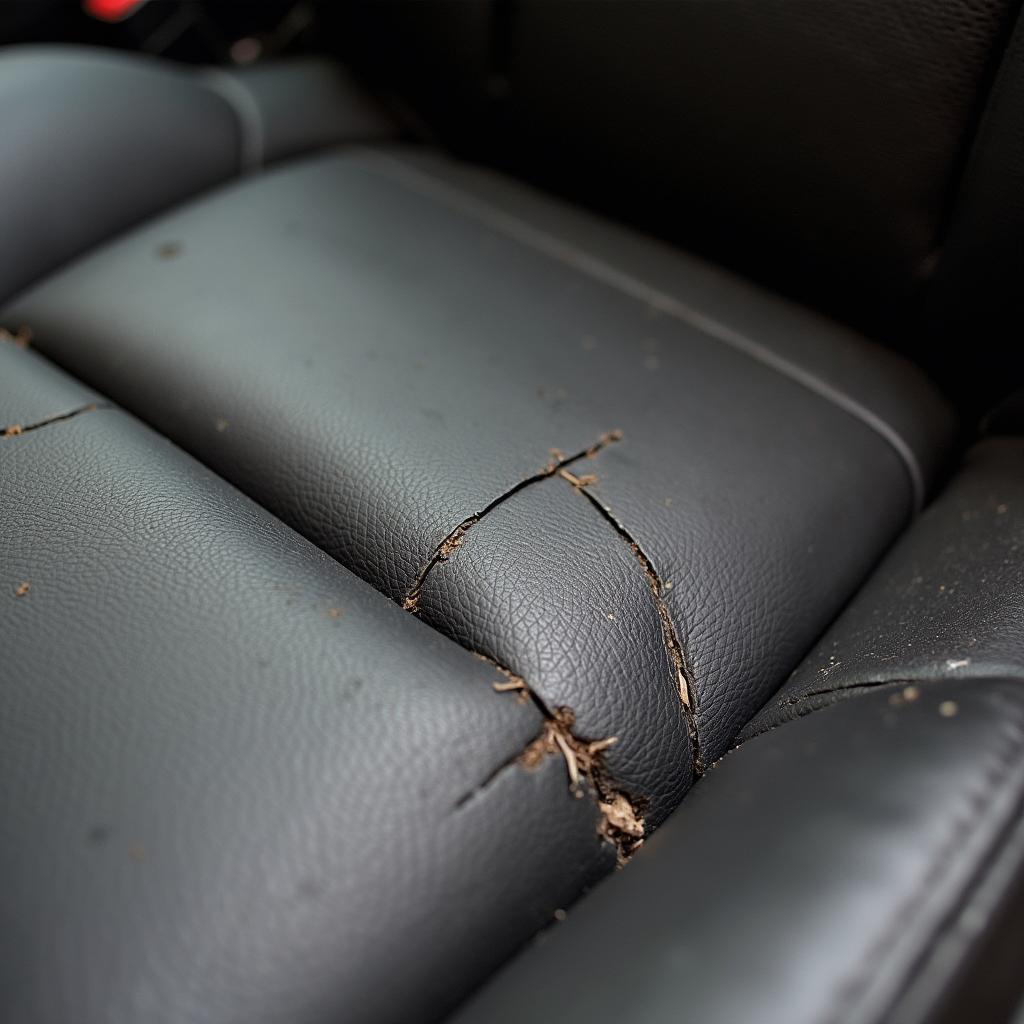Leather car seats are a luxurious and comfortable addition to any vehicle. However, over time, leather can dry out, crack, and fade, especially with constant exposure to heat and sunlight. This can leave your once pristine seats looking worn and damaged. But before you consider replacing the entire seat, there are effective ways to repair cracks in a leather car seat and restore their former glory.
This guide will delve into the intricacies of leather car seat repair, exploring various methods, providing practical tips, and answering frequently asked questions to help you achieve professional-looking results.
Understanding the Causes of Leather Car Seat Cracks
Before diving into repair solutions, it’s crucial to understand what causes cracks in leather car seats in the first place. This knowledge can help you prevent future damage and better care for your leather upholstery. Here are some common culprits:
- Sunlight Exposure: Prolonged exposure to the sun’s harmful UV rays can dry out the leather’s natural oils, making it brittle and prone to cracking.
- Heat: Excessive heat, like that inside a parked car on a hot day, can also dehydrate leather, accelerating the cracking process.
- Lack of Maintenance: Regular cleaning and conditioning are essential for keeping leather supple. Neglecting these practices can lead to dryness and, eventually, cracks.
- Wear and Tear: Frequent use, friction from getting in and out of the car, and abrasive cleaning products can wear down the leather’s protective coating, making it susceptible to damage.
Assessing the Damage: Is it Repairable?
Not all leather damage is created equal. Minor cracks and scratches can often be repaired at home using DIY methods. However, deep cuts, extensive cracking, or tears in the leather may require professional intervention.
DIY Leather Car Seat Crack Repair Methods
For minor cracks and scratches, several do-it-yourself methods can effectively restore your leather car seats. These methods are generally cost-effective and can be done with readily available materials.
1. Cleaning and Preparation: The Foundation of a Successful Repair
Before starting any repair, thoroughly clean the affected area with a dedicated leather cleaner and a soft-bristled brush. This removes dirt, grime, and debris that can hinder the repair process.
Pro Tip: Avoid using harsh household cleaners or ammonia-based products, as these can further dry out the leather and worsen the damage.
2. Leather Filler: Filling in the Gaps
For deeper cracks, use a leather filler to even out the surface. Leather filler is a paste-like substance that dries to a flexible finish, mimicking the look and feel of natural leather. Apply the filler with a palette knife, pressing it firmly into the cracks. Allow it to dry completely according to the manufacturer’s instructions.
3. Leather Dye: Restoring the Color
Once the filler is dry, use a leather dye that matches your car seat’s color to camouflage the repair. Apply the dye in thin, even coats with a sponge or a soft cloth, allowing each coat to dry completely before applying the next. This step helps blend the repaired area seamlessly with the surrounding leather.
Expert Insight: “Choosing the right color match is crucial for a professional-looking finish. When in doubt, consult a leather specialist or visit an automotive upholstery store for assistance.” – John Miller, Automotive Upholstery Expert.
4. Leather Conditioner: Keeping it Supple
After the dye has dried, apply a high-quality leather conditioner to the entire seat. This step is essential for restoring moisture, preventing future cracking, and maintaining the leather’s suppleness.
Can you repair ripped leather car seats?
While minor cracks and scratches can often be repaired with DIY methods, more significant damage like rips, tears, or extensive cracking often requires professional expertise.
For residents of Northampton seeking professional car leather seat repair, we highly recommend checking out our services at car leather seat repair northampton.
When to Consider Professional Leather Car Seat Repair
While DIY methods can be effective for minor damage, professional repair is often the best course of action for more severe cases. Here’s when to consider seeking professional help:
- Extensive Cracking: If the cracks are numerous, deep, or cover a large area, professional repair can provide a more durable and aesthetically pleasing solution.
- Rips and Tears: Repairing rips and tears typically involves patching and stitching, which requires specialized tools and expertise.
- Faded Leather: Professionals can re-dye faded leather to restore its original color and vibrancy.
- Structural Damage: If the damage affects the seat’s structural integrity, such as torn seams or broken frames, professional repair is essential for safety and comfort.
If you’re in the Dundee area and need professional assistance with car leather seat repairs, we recommend visiting our partners at car leather seat repairs dundee.
Preventive Measures: Keeping Your Leather Seats Crack-Free
Prevention is always better than cure. By taking proactive steps to care for your leather car seats, you can significantly reduce the risk of cracks and other damage, extending their lifespan and maintaining their luxurious appearance. Here are some essential tips:
- Regular Cleaning: Clean your leather seats regularly with a dedicated leather cleaner and a soft-bristled brush to remove dirt and grime that can prematurely age the leather.
- Conditioning is Key: Apply a high-quality leather conditioner every few months, or more often if you live in a hot or dry climate, to keep the leather moisturized and prevent drying and cracking.
- UV Protection: Park your car in the shade or use a windshield sunshade to minimize direct sunlight exposure, which can fade and dry out the leather.
- Temperature Control: Avoid parking your car in extreme heat for extended periods. If possible, crack the windows slightly to allow for ventilation.
Frequently Asked Questions (FAQs)
1. How much does it cost to repair cracked leather car seats?
The cost of leather car seat repair can vary widely depending on several factors, including the severity of the damage, the type of leather, the repair method used, and the location of the repair shop.
For a detailed breakdown of leather car seat repair costs, you can refer to our comprehensive guide on how much to repair cracked leather car seats.
2. Can I use regular superglue to repair cracks in my leather car seat?
Using superglue or other household adhesives is not recommended for repairing leather car seats. These adhesives are not designed for use on leather and can cause further damage, such as hardening the leather, discoloring it, or creating an uneven surface.
3. How often should I condition my leather car seats?
It’s generally recommended to condition your leather car seats every three to six months. However, if you live in a hot or dry climate, or if your seats are frequently exposed to sunlight, you may need to condition them more often.
4. Can I repair a tear in my leather car seat myself?
While you can attempt to temporarily patch a small tear using a leather repair kit, it’s generally recommended to have tears professionally repaired for a more durable and aesthetically pleasing result. If you’re interested in learning more about repairing car seat seams, we have a comprehensive guide on how to repair car seat seam.
Conclusion: Restore Your Leather Car Seat’s Former Glory
Cracks in your leather car seats don’t have to be a permanent blemish. By understanding the causes of damage, exploring various repair options, and adopting preventive measures, you can restore your leather upholstery to its former glory, enhancing the overall aesthetic appeal and value of your vehicle. Remember, whether you choose a DIY approach or seek professional assistance, addressing cracks promptly is key to preventing further damage and maintaining the luxurious comfort of your leather car seats.



